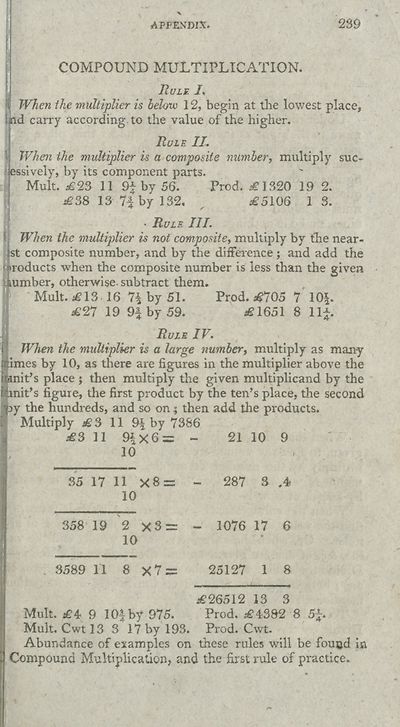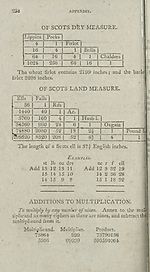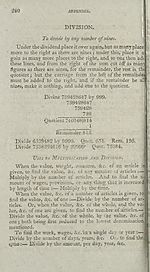Download files
Complete book:
Individual page:
Thumbnail gallery: Grid view | List view

APPENDIX.
239
COMPOUND MULTIPLICATION.
Rule /.
When ihe multiplier is below 12, begin at the lowest place,
id carry according to the value of the higher.
Rule II.
LWhen the multiplier is a composite number, multiply sue-
.sively, by its component parts.
Mult. £23 11 by 56. Prod. £1320 19 2.
£38 13 7^ by 132. _ £5106 1 3.
• Rule III.
When the multiplier is not composite, multiply by fhe near-
st composite number, and by the difference ; and add the
noducts when the composite number is less than the given
lumber, otherwise, subtract them.
Mult. £13 16 7± by 51. Prod. £705 7 10|.
£27 19 9* by 59. £1651 8 ll£.
Rule IV.
When the multiplier is a large number, multiply as many
imes by 10, as there are figures in the multiplier above the
mit’s place ; then multiply the given multiplicand by the
mil’s figure, the first product by the ten’s place, the second
jy the hundreds, and so on; then add the products.
Multiply £3 11 9^ by 7386
£3 11 9^X6= - 21 10 9
10
35 17 11 X8= - 287 3 ,4.
10
358 19 2 X3= - 1076 17 6
10
3589 11 8 X7= 25127 1 8
£26512 13 3
Mult. £4. 9 lOfby 975. Prod. £4382 8 5f.
Mult. Cwt 13 3 17 by 193. Prod. Cwt.
Abundance of examples on these rules will be fouad in
Compound Multiplication, and the first rule of practice.
239
COMPOUND MULTIPLICATION.
Rule /.
When ihe multiplier is below 12, begin at the lowest place,
id carry according to the value of the higher.
Rule II.
LWhen the multiplier is a composite number, multiply sue-
.sively, by its component parts.
Mult. £23 11 by 56. Prod. £1320 19 2.
£38 13 7^ by 132. _ £5106 1 3.
• Rule III.
When the multiplier is not composite, multiply by fhe near-
st composite number, and by the difference ; and add the
noducts when the composite number is less than the given
lumber, otherwise, subtract them.
Mult. £13 16 7± by 51. Prod. £705 7 10|.
£27 19 9* by 59. £1651 8 ll£.
Rule IV.
When the multiplier is a large number, multiply as many
imes by 10, as there are figures in the multiplier above the
mit’s place ; then multiply the given multiplicand by the
mil’s figure, the first product by the ten’s place, the second
jy the hundreds, and so on; then add the products.
Multiply £3 11 9^ by 7386
£3 11 9^X6= - 21 10 9
10
35 17 11 X8= - 287 3 ,4.
10
358 19 2 X3= - 1076 17 6
10
3589 11 8 X7= 25127 1 8
£26512 13 3
Mult. £4. 9 lOfby 975. Prod. £4382 8 5f.
Mult. Cwt 13 3 17 by 193. Prod. Cwt.
Abundance of examples on these rules will be fouad in
Compound Multiplication, and the first rule of practice.
Set display mode to:
![]() Universal Viewer |
Universal Viewer | ![]() Mirador |
Large image | Transcription
Mirador |
Large image | Transcription
| Antiquarian books of Scotland > Education > Complete treatise on practical arithmetic and book-keeping > (253) |
|---|
| Permanent URL | https://digital.nls.uk/114436606 |
|---|
| Description | Thousands of printed books from the Antiquarian Books of Scotland collection which dates from 1641 to the 1980s. The collection consists of 14,800 books which were published in Scotland or have a Scottish connection, e.g. through the author, printer or owner. Subjects covered include sport, education, diseases, adventure, occupations, Jacobites, politics and religion. Among the 29 languages represented are English, Gaelic, Italian, French, Russian and Swedish. |
|---|

